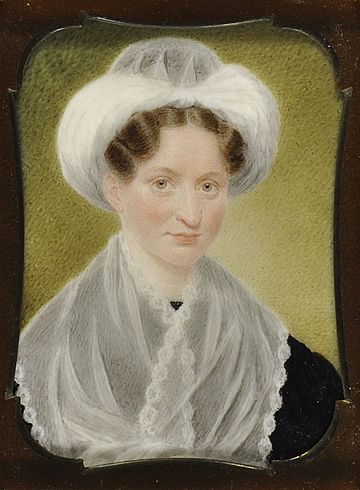History of higher education in the United States facts for kids
The history of higher education in the United States tells the story of how colleges and universities in America grew from a few small schools in the 1600s to the many famous institutions we have today. American higher education is known all over the world.
Contents
Early American Colleges: The Colonial Era
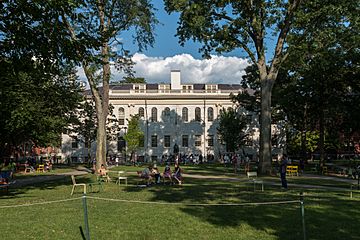
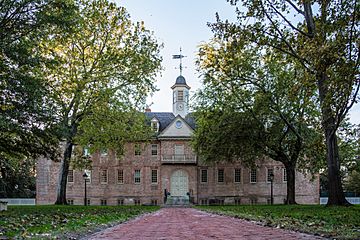
Most of the first colleges were started by religious groups. They wanted to train ministers for their churches. These early schools were like the famous Oxford and Cambridge universities in England.
Harvard College was founded in 1636 in Massachusetts. It was named after an early helper. Most of its money came from the colony itself. Harvard first focused on training young men to become ministers. The Puritan government, whose leaders had gone to Oxford or Cambridge, strongly supported it.
The College of William & Mary was started in Virginia in 1693. It received a lot of land and a small tax on tobacco to help pay for it. This college trained many lawyers, politicians, and important landowners.
Yale College began in 1701. It moved to New Haven, Connecticut, in 1716. Conservative Puritan ministers in Connecticut wanted their own school. They felt Harvard's ideas were becoming too liberal.
Other colleges soon followed:
- In 1747, Presbyterians started the College of New Jersey, which later became Princeton University.
- The Church of England started King's College in New York City in 1746. After the American Revolutionary War, it was renamed Columbia University.
- Baptists founded Rhode Island College in 1764. It was later renamed Brown University. Brown was special because it welcomed students from different religious groups.
- Benjamin Franklin helped start the Academy of Pennsylvania in 1749 in Philadelphia. It became the College of Philadelphia in 1755. Unlike other schools, it didn't focus on training ministers. It later became the University of Pennsylvania.
- The Dutch Reformed Church started Queen's College in New Jersey in 1766. This school later became Rutgers University.
- Dartmouth College was chartered in 1769 and moved to Hanover, New Hampshire, in 1770.
The Idea of a National University
Many early American leaders wanted a national university. They thought it would help unite the new country. Leaders like George Washington, Benjamin Rush, and Thomas Jefferson supported this idea. They believed it would promote learning and keep up with European schools. However, others worried about the cost and didn't like the idea of a single, powerful university. This dream didn't come true, but it led to other national centers like the Smithsonian Institution.
Colleges in the 1800s
In the 1800s, many Protestant and Catholic churches opened small colleges. Most of these schools taught in English.
Colleges on the Frontier
On the western frontier, Transylvania University in Kentucky was very important. It started in 1780 and offered law and medical programs. Many future politicians and leaders from the Southwest went there. Most early colleges were funded by churches. Public colleges and universities, like many of the first HBCU's, started later with help from the Morrill Land-Grant Acts in 1862 and 1890.
What Students Studied (Curriculum)
Early colleges were small. Students mainly studied the liberal arts. They learned Greek, Latin, geometry, ancient history, logic, ethics, and public speaking. There were few discussions or lab classes. Students were expected to repeat what they learned exactly. The college president usually kept strict rules. Many students were under 17, and some colleges also had a prep school.
By the 1820s, some people wanted to replace Greek and Latin with modern languages. But the Yale Report of 1828 defended the traditional curriculum. It wanted to keep old traditions, even as German universities became famous for research. The classical languages stayed important until after the Civil War. For example, East Alabama Male College, a Methodist school, focused on Latin, Greek, and moral science. It later became Auburn University, adding new courses in agriculture and industrial arts.
How 19th-Century Colleges Made a Difference
Many American scholars went to German universities before 1914. They came back with PhDs and helped create research-focused universities in the U.S. These included Cornell, Johns Hopkins, Chicago, and Stanford. Older schools like Harvard and Columbia also improved their research programs.
Small liberal arts colleges also did well. They helped young men move from farm life to jobs in cities. These colleges especially helped people become ministers, who then became community leaders. More exclusive colleges, like Harvard, focused on students from wealthy families. This helped create a powerful group of leaders in the Northeast.
Law and Medical Schools Begin

In the early days, there were no law schools in the American colonies. Lawyers learned by working with experienced lawyers. Medicine was also very basic. Many doctors learned as apprentices. The Perelman School of Medicine at the University of Pennsylvania was founded in 1765. King's College in New York started a medical department in 1767. It awarded the first American M.D. degree in 1770. This is now Columbia University Vagelos College of Physicians and Surgeons.
Women and African Americans in College
Mary Lyon started Mount Holyoke Female Seminary in 1837. It was the first college opened just for women. Today, it is Mount Holyoke College, one of the famous Seven Sisters schools. Wesleyan College opened in 1839 as the first Southern college for women.
Oberlin College in Ohio became the first coeducational college in 1837. This means it admitted both men and women. Women soon made up a large part of the student body. Oberlin was also the only college to admit black students in the 1830s. However, by the 1880s, the school started separating its black students again.
More and more women went to college after the Civil War. In 1870, about 21% of college students were women. By 1930, this number grew to 44%.
| College women enrollment |
Women's colleges | Coed-colleges | % of all students |
|---|---|---|---|
| 1870 | 6,500 | 2,600 | 21% |
| 1890 | 16,800 | 39,500 | 36% |
| 1910 | 34,100 | 106,500 | 40% |
| 1930 | 82,100 | 398,700 | 44% |
| Source: |
Giving Back: Philanthropy and Funding
Wealthy families often supported local schools, especially those of their own religion. They would donate land or money. Rich people like Johns Hopkins, Leland Stanford, and Andrew Carnegie started major universities. John D. Rockefeller funded the University of Chicago without putting his name on it.
Religious groups also raised money to help students who wanted to become ministers. The American Education Society, started in 1815, helped colleges and seminaries keep high academic standards.
Land Grant Universities: Education for All
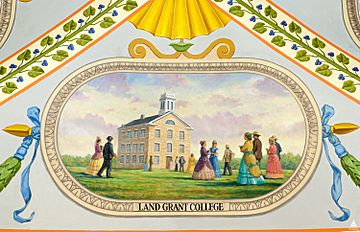
The Morrill Land-Grant Colleges Acts of 1862 and 1890 used federal money to create "land grant colleges" in each state. These schools focused on agriculture and engineering.
Some of the first land-grant universities included Iowa State University, Purdue University, Michigan State University, Kansas State University, and Cornell University. These schools helped improve farming and led to new technologies. Their graduates played a big role in the growth of American industry and business.
Pennsylvania State University is a good example. It started as the Farmers' High School of Pennsylvania in 1855. It aimed to teach farmers how to be more successful. Students had to do farm work to help pay their way. Later, it added military training. It became a center for middle-class students seeking white-collar jobs.
Black Land Grant Colleges
In 1890, Congress also funded all-black land-grant colleges. These schools mainly trained teachers. They helped rural communities, especially through programs like the traveling school started by the Tuskegee Institute in 1906. Booker T. Washington, Tuskegee's founder, was a very important black leader. He got many grants from wealthy people to support these schools. These colleges also helped train students from other countries to improve farming.
Higher Education in the 1900s
At the start of the 20th century, there were fewer than 1,000 colleges in the U.S. with about 160,000 students. The number of colleges and students grew very quickly, especially between 1900–1930 and 1950–1970. State universities became much larger. Many states also set up colleges to train teachers, which later became full universities.
| Year | Bachelor's degrees | Master's degrees | PhD degrees |
|---|---|---|---|
| 1870 | 9,400 | NA | 1 |
| 1890 | 15,500 | 1,000 | 149 |
| 1910 | 37,200 | 2,100 | 440 |
| 1930 | 122,500 | 15,000 | 2,300 |
| 1950 | 432,000 | 58,200 | 6,600 |
| 1970 | 827,000 | 208,000 | 29,900 |
| 1990 | 1,052,000 | 325,000 | 38,000 |
| 2009 | 1,600,000 | 657,000 | 67,000 |
| source: census |
Advanced Degrees: Graduate Programs
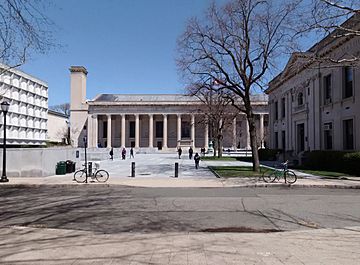
For a long time, professors didn't need advanced degrees. But in the mid-1800s, many American scholars went to Germany to get a Doctor of Philosophy (PhD) degree. Slowly, graduate schools started in the U.S. Yale and Harvard began giving out PhDs in the 1860s and 1870s.
A big change happened with the opening of Clark University, which only had graduate programs, and Johns Hopkins University, which focused on its PhD program. By 1900, about 6,000 students were in graduate programs. The top six universities awarded around 300 PhDs each year.
In the U.S., private and state universities were independent. Funding was often low until private foundations and corporations started supporting research. After World War II, state universities grew a lot. They added more research programs for master's and doctorate degrees. Professors needed to publish their research to get ahead.
Junior Colleges Become Community Colleges
A new trend was the growth of junior colleges. These were often started by city school systems in the 1920s. By the 1960s, some were renamed "community colleges."
Junior colleges grew quickly. They offered low-cost training for office jobs and technical jobs. They also helped students prepare to transfer to four-year universities. They are still open-enrollment, affordable schools that help a wide range of students.
The Great Depression and Colleges
The Great Depression in 1929 was tough for colleges. Only the richest schools had enough money to handle the losses. Smaller schools faced big budget cuts. Universities had to cut salaries, stop hiring, and reduce spending on buildings and research.
For example, Northwestern University's income dropped by 25%. They cut salaries by 10% for all staff. However, a large gift of $6 million in 1935 helped them recover. State colleges also struggled because they relied on government funding, which was cut. The Works Progress Administration (WPA) and Public Works Administration (PWA) helped by building new facilities for public universities. The New Deal also gave money to needy students for part-time work.
The GI Bill: Helping Veterans Go to College
After World War II, Congress passed the G.I. Bill in 1944. This law helped millions of veterans go to college by paying for their tuition and living expenses. It made higher education possible for many young men who might not have gone otherwise. Veterans were about 10% more likely to attend college than non-veterans. Most campuses became mostly male because of the GI Bill. However, by 2000, more women than men were attending college.
The Great Society and Education
Under President Lyndon B. Johnson, Congress passed many Great Society programs in 1964. The Higher Education Act of 1965 created federal scholarships and low-interest loans for college students. It also helped improve libraries, create new graduate centers, and build more classrooms. This law greatly increased federal support for education.
For-Profit Universities
In the late 20th century, many for-profit colleges appeared. These schools often attracted students with lower incomes or veterans, who could use federal loans or benefits to pay tuition. These colleges have faced some criticism. This is because many students don't finish their degrees or struggle to find good jobs afterward. Some students also have trouble paying back their federal loans.
Catholic Colleges and Universities
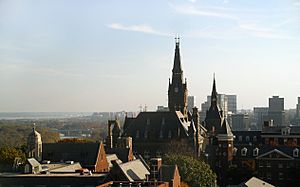
Georgetown University was the first Catholic college in the U.S. Many small Catholic colleges from the 1800s have grown into major universities today. The Association of Catholic Colleges and Universities was founded in 1899. It helps these schools share information and ideas.
Nuns and dioceses also started many colleges for women. The College of Notre Dame of Maryland opened in 1895 as a four-year college for women. It later became Notre Dame of Maryland University and started accepting men. By 1955, there were 116 Catholic colleges for women. Most of them became co-ed, merged, or closed after 1970.
Higher Education in the 2000s
The 21st century has seen more growth in for-profit colleges and online learning. Student enrollment reached its highest point around 2010. After that, enrollment at community colleges, for-profit colleges, and smaller schools started to drop. However, online education continued to grow. In 2020 and 2021, the government gave billions of dollars to schools to help them during the COVID-19 pandemic.
|


